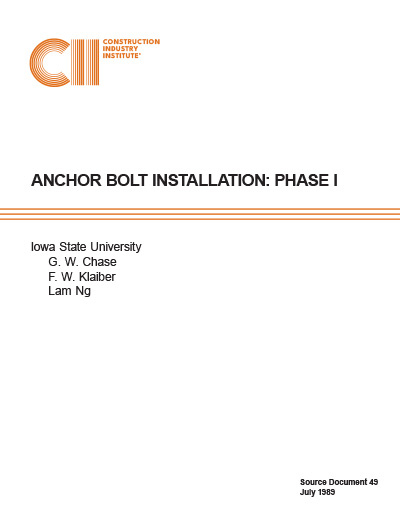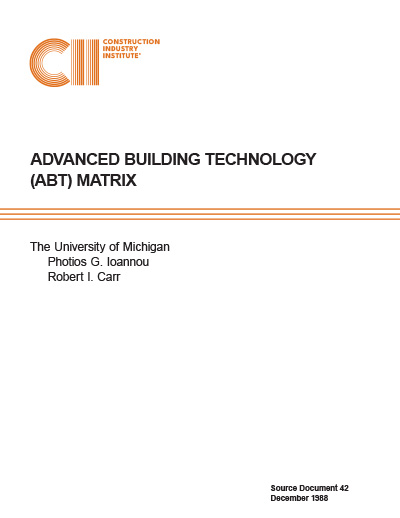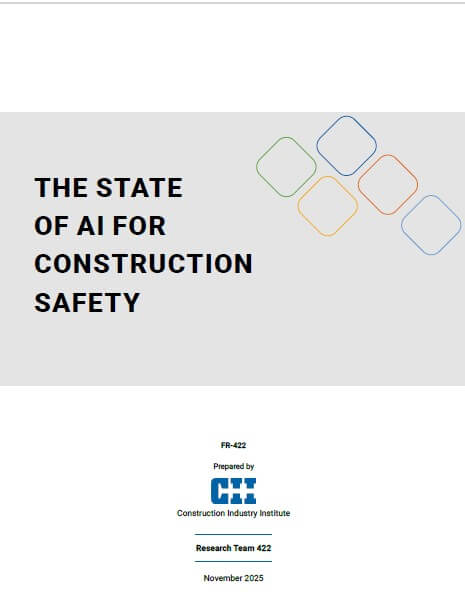
Anchor Bolt Installation: Phase I
The Construction Industry Institute (CII) funded this research project for the purpose of seeking a more cost-effective method of installing anchor bolts.
The topic of anchor bolts is far-ranging—from small anchor bolts (as small as 1/4 in. in diameter) that might be shot or drilled in place to large, multiple-inch-diameter anchor bolts (several feet long, cast-inplace—either as one piece or assembled as several pieces). Many commercial anchor bolt systems are currently in use in the construction industry. In the United States alone, there are 17 manufacturers who furnish anchor bolt systems. Materials, installation methods, and costs vary widely.
As previously noted, CII desired a study of the area of anchor bolt design and construction with a view to looking for systems that might be more cost effective than the traditional systems now used.
This report covers the first of two proposed phases. This first phase is a literature review, with the following objectives:
- Obtain descriptive information on existing anchor bolt systems
- Review available data on design, installation, and performance
- Select promising systems for additional study in Phase II
- If found necessary, propose modifications to existing systems and propose new systems
This investigation has determined that there is a considerable amount of published information on anchor bolts and anchorage systems. In fact, shortly after this investigation was initiated, committee 355 of the American Concrete Institute (ACI) issued a draft of its report, State of the Art: Anchorage to Concrete. In addition to that report, ACI also published in 1987 a special publication, SP-103, Anchorage to Concrete. This latter publication includes papers that report on several recent significant investigations affecting anchor bolt design and installation. (Several of these are referenced later.)
Because the ACI committee report is a state-of-the-art publication, there is a potential for duplication between that report and this report. The investigators for this project have tried not to duplicate the material in the ACI report; however some duplication of material may be inevitable.
The field of information concerning anchor bolts is growing every day, and research results are constantly being published. For example, the March–April 1988 issue of the ACI Materials Journal contains two articles relating to anchor bolt behavior in concrete.
The first concerns bar pull-out tests in super-plasticized concrete, and the second concerns pull-out tests in fiber-reinforced silica-fume concrete. Both of these areas, concrete with additives and high-strength concrete, will have an effect on current design and construction procedures. At the present time no mechanism exists for incorporating such results in a timely and widely distributed manner into industry design standards and guides. Those standards and guides that do exist do not appear to be revised on a regular basis.
From the beginning, we realized that this investigation could not adequately cover the entire range of anchorage products, and that there must be some limitation in scope. As a result, it was decided to limit this investigation to cast-in-place anchors and drilled-in anchors 1/2 in. in diameter and larger. Inserts, such as plates with welded studs and inserts that are prevalent in tilt-up panel construction, have not been specifically addressed. Instead, the focus is more toward the types of anchor bolt systems that are used to anchor machinery, structural columns, and cylindrical towers, such as cracking towers. Although overhead anchorage systems have not been deliberately excluded, the investigation has concentrated instead on anchorages in foundations, floors, and walls.
In the following sections we discuss the approach that was taken in the investigation, the results of the literature search, the results of direct contact with users and designers, and our conclusions and recommendations.
The collection of research on anchor bolt design includes CII’s initial review of current knowledge regarding anchor bolt installation circa 1989. One of the biggest contributions to the construction industry in the area of anchor bolts is the development of comprehensive design and construction standards along with illustrated application, design, and construction guides.
The industry commonly uses two major categories of anchor bolt systems: cast-in-place and drilled-in anchors. (SD-49, p. 5)
- Cast-in-place anchors have two major types (see their detailed descriptions in the research materials).
- Nonadjustable Cast-in-Place Anchors
- Adjustable Cast-in-Place Anchors
- Drilled-in anchors have three major types, also detailed in the research materials.
- Expansion Anchors
- Undercut Anchors
- Adhesive Anchors
In addition, the research suggests the need for the development of a comprehensive design and construction standards guide for anchor bolts. For more detailed information on anchor bolts, this research suggests American Concrete Institute (ACI) as the industry expert.



